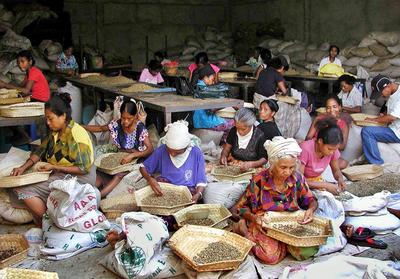But many local NGOs like Oxfam and PANG are sceptical about free trade agreements and are instead pursuing and promoting non-WTO committing strategies such as Fairtrade.
Fairtrade is a certification available to products that meet the international Fairtrade principles and standards for producers and traders, set up by the Fairtrade Labelling Organisation. Fairtrade companies pay a ‘Fairtrade Minimum Price’ to producers to cover the costs of sustainable production. This amount is agreed upon prior to production. A ‘Fairtrade Premium’ is also collected and paid to the producer cooperatives that represent the respective farmers. The Premium is used by the cooperative for capacity building in every aspect of life (like education). The increased cost of Fairtrade products is financed by consumers who are willing to pay a higher price for them because of the perceived social and environmental benefits.
Fairtrade proponents use case studies of Fairtrade-participating farmers to show that it is more beneficial to small-scale farmers than free trade.
Some of these case studies have identified higher levels of education and health and greater awareness of social and environmental issues among farming communities operating within Fairtrade cooperatives. Fairtrade farmers also have better access to credit, and studies show instances of higher levels of management and organisational skills which increase productivity, household income and make farmers more influential.
Other assessments of Fairtrade have been more critical. For example, the Adam Smith Institute (ASI) finds that Fairtrade leads to the possibility of increasing income inequalities by offering a minority, which is already better off, access to credit to further their economic advantage.
Other commentators suggest Fairtrade does not improve the labour rights of hired workers, and its contribution to the overall reduction of poverty and development is negligible.
One study concludes that Fairtrade does not help those who suffer the severest poverty, namely agricultural labourers, but helps the landowners instead. In such cases any benefit is built into the price of rent for land.
Fairtrade may add to the productivity of participating farmers by increasing supply, but this lowers the price in the conventional produce market, negatively affecting all non-Fairtrade producers.
According to the ASI, only about 10 per cent of the additional Fairtrade Premium, paid by consumers, actually goes to small scale producers. Farmers claim they do not realise a net gain from these higher prices. There are two reasons for this. The first is the more intensive and therefore costlier management requirements related to Fairtrade standards relative to a free market situation. The second is that the progressive nature of Fairtrade affects the production process, compromising local decision making and control.
Although consumers pay considerably higher prices for Fairtrade products, research finds that a much larger share of the relatively-high retail price remains in the consuming country than in the case of conventional free market commodities. Fairtrade is found to empower processors and retailers instead of the farmers.
Analysis of the PICs suggests that small-scale farmers have particular difficulty in meeting Fairtrade standards. For example, capacity constraints and issues related to traditional culture prevent mainly poor, small scale farmers in Papua New Guinea (PNG) and Timor-Leste from selling their produce (coffee, tea and cocoa) as Fairtrade certified. By supporting Fairtrade, consumers indirectly reject and penalise these farmers in Australia’s neighbouring countries, and instead support more developed, small to medium small scale farmers and land owners outside the region.
On the other hand, free trade as it exists under the SPARTECA arrangement has been highly successful in PNG. For Timor-Leste, Australia’s General System of Preferences has helped the countries’ coffee producers to export to the Australian market. Free trade has reduced poverty through a variety of channels and avenues, as well as providing real market access opportunities for all producers, thus making it truly fair trade. In this context, a more liberalising reciprocal PACER Plus trade agreement currently being negotiated between the PICs and Australia and New Zealand has the potential to be a far more beneficial development tool than Fairtrade.
Uwe Kaufmann is a Economic Research Analyst with the Institute for International Trade and a doctoral candidate at the School of Economics at the University of Adelaide. Di Yuan, Faqin Lin and Altaf-Ul Alam are are doctoral candidates at the School of Economics, University of Adelaide.

